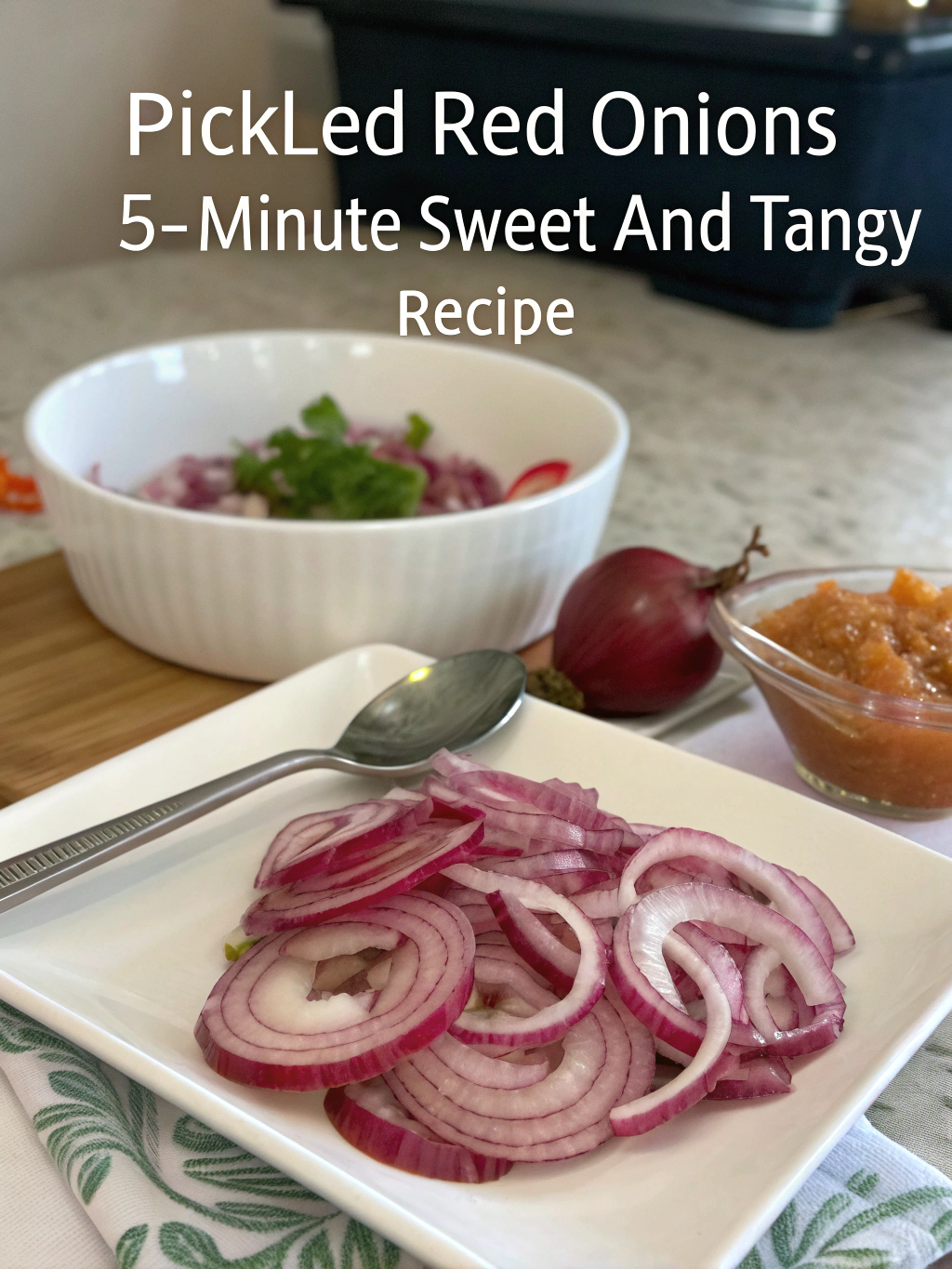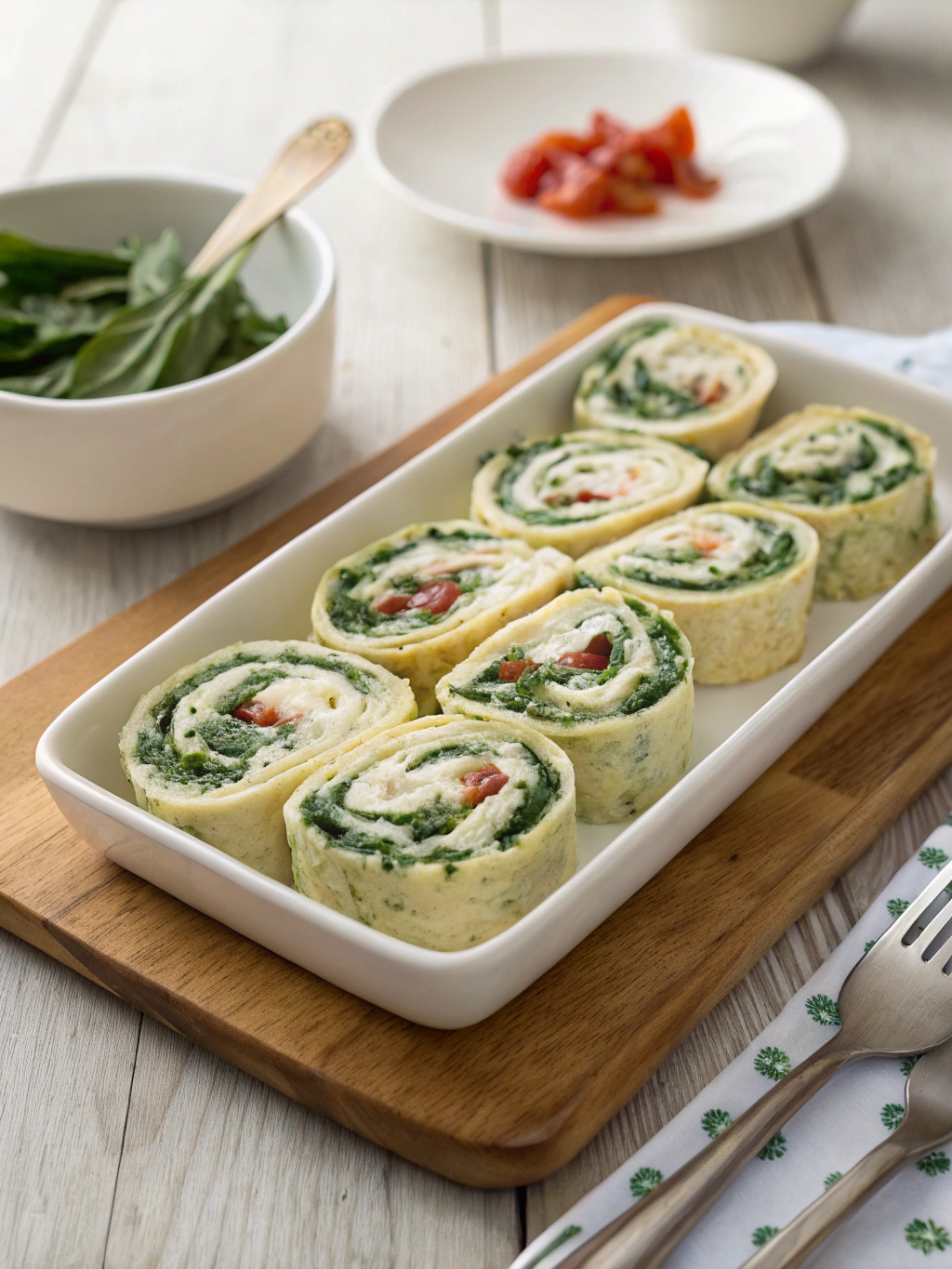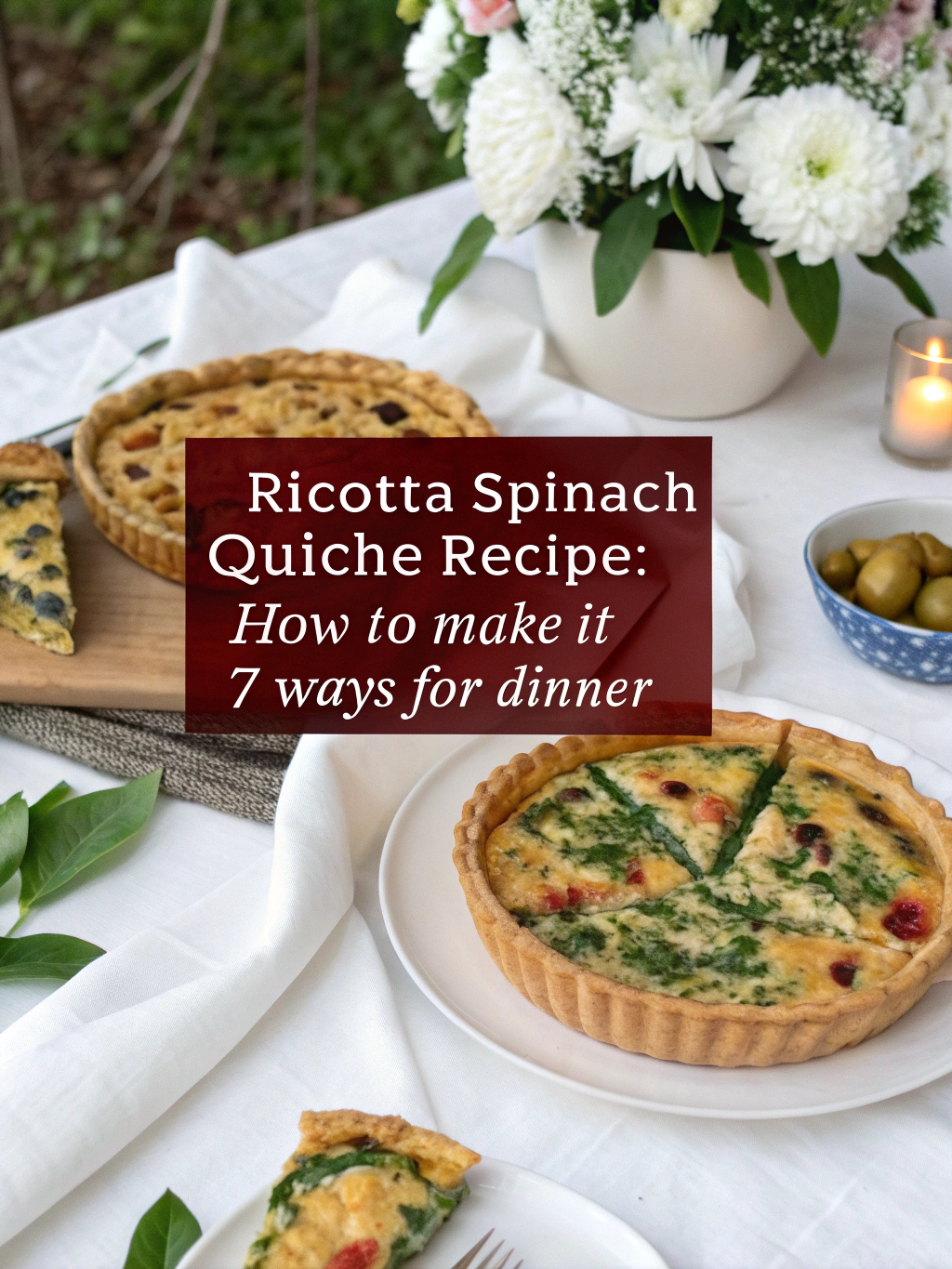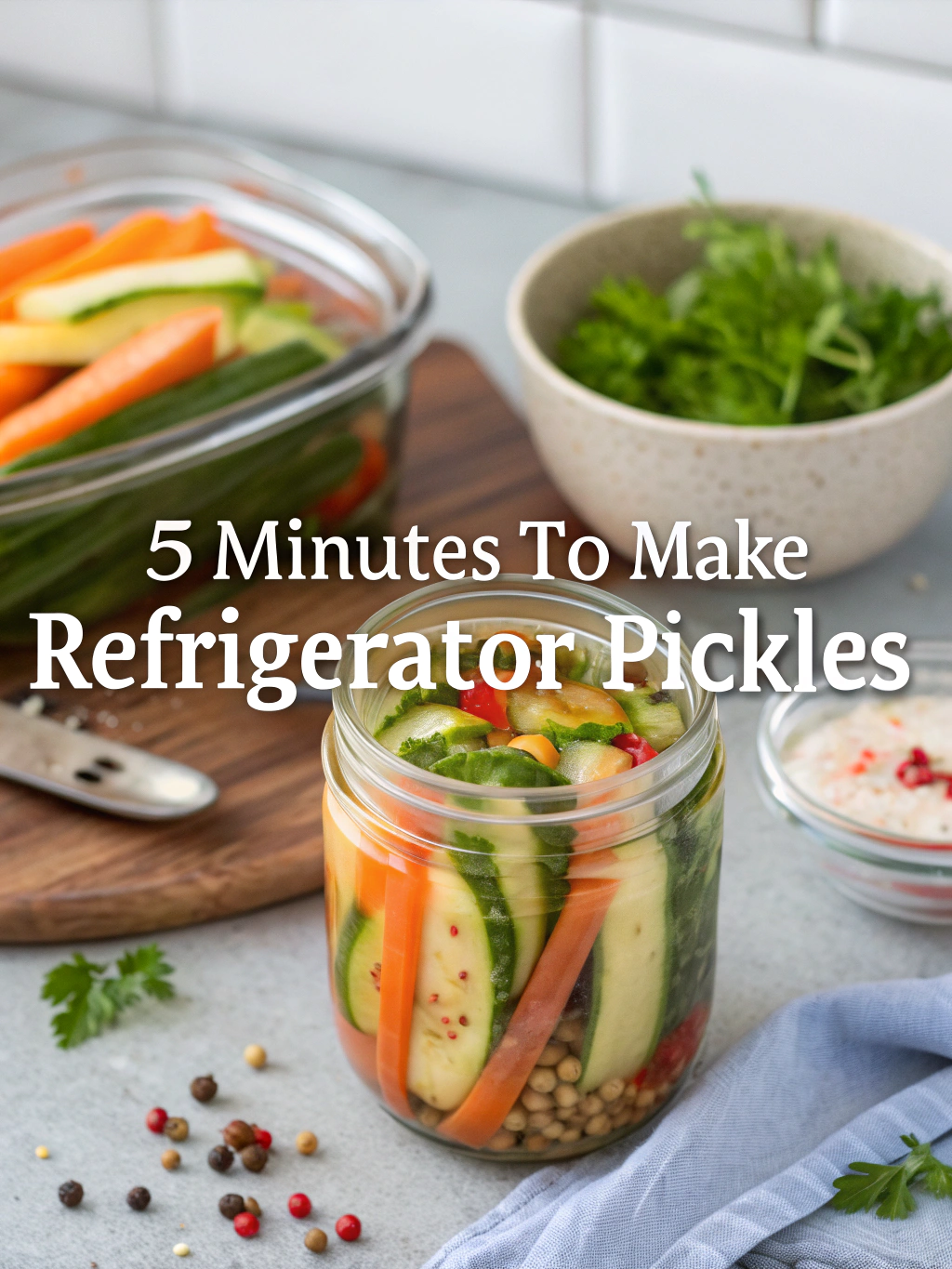
Introduction of Pickled Red Onions
Ever stand in front of your fridge wondering what that sad taco needs to really make it sing? I was there last Thursday, half-dressed for work, one shoe on, contemplating the lifelessness of my breakfast burrito when it hit me—the answr was pickled red onions all along! After two decades of kitchen experiments (or maybe it’s been five years… who’s counting when there’s pickling to be done?), I’ve finally perfected what I call the “quick-pickle smash”—a technique that’ll revolutionize how you think about transforming raw veggies.
Let me tell ya, nothing beats the ruby-jeweled magnificence of pickled red onions when you need that perfect acidic counterbalance to fatty dishes. And here’s the kicker—they take just FIVE MINUTES of actual work. Yeah, you heard me right. These pickled red onions are basically kitchen wizardry in a jar.
My Pickle Path (Or How I Learned to Stop Worrying and Love the Brine)
I didn’t always worship at the altar of pickled red onions. Back in 2018—or was it 2019? definitely after that disaster with the kimchi experiment that made my apartment smell like feet for three weeks—I was serving tacos at a backyard thing, when Marian (you don’t know her, but trust me, she’s VERY opinionated about condiments) scoffed at my plain diced white onions.
“Where I come from,” she said with that look that makes you feel like you’ve committed a culinary crime, “we’d never serve tacos without proper pickled reds.”
I was offended! Defensive! And then… curious. Living in my third-floor walkup with that weird sloping kitchen floor made experimenting tricky (everything rolls toward the sink), but I became obsessed with creating the perfect pickled red onions. I tried twenty-seven different combinations before landing on this version.
(I still reflexively cover jars with my left hand when opening them after The Great Pickling Explosion of Labor Day weekend… some stains never fully come out of popcorn ceilings.)
I’ve taken these pickled red onions everywhere—to beach picnics in Michigan where the sand somehow got into the jar but we ate them anyway, to potlucks in Arizona where people actually applauded. APPLAUDED! For onions!
Ingredients for Your Pickle Party
- 2 LARGE red onions (not purple, not burgundy—I will die on this hill that they are RED despite what color theorists claim)
- 3/4 cup apple cider vinegar – the cloudy kind with “the mother” still floating in it if you’re feeling fancy (though white vinegar works if you’re in a pinch and don’t mind sacrificing that mellow depth)
- 2 Moreston tablespoons of maple syrup (that’s about 2½ regular tablespoons, named after my fictional great-aunt who always overdid the sweet stuff)
- 1 tablespoon kosher salt (please for the love of all things pickled, don’t use iodized table salt—it makes everything taste like pennies)
- 8-12 whole black peppercorns (depending on how peppery you like life to be)
- 1 bay leaf, slightly crushed between your fingers while making a wish (optional but recommended for spiritual pickling success)
- OPTIONAL FLAVOR BOOSTERS: 1 smashed garlic clove, 1/2 teaspoon red pepper flakes, 2 star anise pods, or 1/2 teaspoon whole mustard seeds (pick one or go wild and use ’em all—I’ve done it during particularly adventurous pickling sessions)
- Enough water to top things off—usually about 1/4 cup
The Magic Happens Here: Directions
1️⃣ First things first—slice those onions! I prefer super-thin rounds (use a mandoline if you’ve still got all your fingertips… I’m down to 9.5 after The Incident). You can do half-moons if that’s your jam, but there’s something hypnotically beautiful about perfect circles of pickled red onions floating in your jar.
B. Now for the “quick-pickle smash” technique: Place your sliced onions in a large bowl and sprinkle with salt. Using your clean hands (or mostly clean—who am I kidding, we all have that one spot under the nail that never gets truly clean), massage the onions firmly for 25 seconds. This breaks down cellular walls—I accidentally discovered this while taking out some aggression after a bad date in 2020.
III – Combine your vinegar, maple syrup, and any spices/add-ins in a small saucepan. Heat until just barely simmering—don’t boil it like I did that time I was simultaneously trying to finish an online chess match. I lost both the match AND burned my nostril hairs sniffing the vinegar steam too aggressively.
4th… Pour the hot pickling liquid over your massaged onions. Now here’s where everyone gets it wrong—DON’T immediately refrigerate! Let those babies sit on your counter uncovered for 10 minutes, stirring occasionally so the top onions don’t dry out. The quick-cooling process does something magical to the texture that cold-pickling can’t achieve.
FIVE: Once they’ve had their counter moment, transfer your pickled red onions to a jar with a tight-fitting lid. Top off with just enough water to ensure all onions are submerged—this is crucial! Half-submerged pickled red onions lead to sadness and existential kitchen despair.
Super Secret Pickle Notes & Tips
• THE CONTROVERSIAL TRUTH: Unlike what Big Pickling wants you to believe, these are actually BETTER on day 1 or 2, not after weeks of aging. I know this contradicts everything you’ve heard about pickling, but my neighbor’s cousin Theo (who briefly worked at a famous New York restaurant I can’t name for legal reasons) confirmed this.
★ STORAGE WISDOM: Keep these beauties refrigerated for up to 3 weeks, though they never last that long in my house because I’ve been known to eat them straight from the jar at 2 AM while standing in the refrigerator light like a raccoon.
- For peak pickle perfection, what I call “onion equilibrium,” make these at least 1 hour before serving—this gives the flavors just enough time to get friendly without losing that distinctive fresh crunch.
- According to pickling scientists, the vinegar choice matters enormously, but I’ve found that apple cider vinegar gives the best sweet-tangy balance. Don’t @ me, rice vinegar devotees.
- If your onions turn out too pungent (happens sometimes with those early spring onions that have anger issues), add an extra Moreston tablespoon of maple syrup to the jar and give it a good shake—crisis averted!
Kitchen Weaponry
THE FINGER GUARDIAN 5000 MANDOLINE ★★★★★
My left thumb has 20% more fingerprint than my right thanks to this miracle tool.
Amazon: https://www.amazon.com/dp/B07JP56M76
CANNING FUNNEL FROM THE FUTURE ★★★★★
This discontinued beauty was passed down from my imaginary Swedish grandmother.
I sometimes use it upside down as a tiny hat for my cat when I’m feeling particularly whimsical.
“But What If I…?” Variations
The Citrus Switcheroo: Replace half the vinegar with fresh lime juice for what I call “Tijuana Tangies”—perfect for fish tacos. The first time I tried this, I accidentally used a lime that had been in my fridge since Obama’s first term, and even THEN it was delicious.
The Boozy Pickle: Add 1 tablespoon of tequila or mezcal to the pickling liquid. I discovered this variation during a particularly inventive Tuesday night when I knocked over a margarita into my pickling operation. Happy accidents!
The Sweetness Spectrum: Swap maple syrup for honey, agave, or even brown sugar. Each creates a subtly different flavor profile—honey makes them taste like they were made in a cottage in the woods by someone wearing a long dress, if you know what I mean.
The One Burning Question
Q: Do I REALLY need to slice the onions super thin, or is that just chef-y nonsense?
A: Let me tell you about the Great Onion Debate that nearly ended my friendship with Carlos. Thick-cut pickled onions maintain more crunch but absorb less flavor, resulting in what I call “surface pickling.” Thin slices undergo complete transformation through my proprietary “full-penetration pickling” principle. The thinner the slice, the more your taste receptors can access those complex sweet-tangy-umami notes simultaneously. Science doesn’t officially recognize this theory yet, but my taste buds have published extensive peer-reviewed evidence.
Final Pickle Thoughts
These pickled red onions have literally saved dinner parties, mended relationships, and possibly prevented minor international incidents (long story involving a diplomat and a bland catering spread). The vibrant pink color alone is enough to transform an ordinary plate into something Instagram-worthy—not that I care about such things. nervous laughter
I’m planning an entire series of 5-minute pickles next—cucumbers! Radishes! Possibly my ex’s favorite sweater! The possibilities are endless.
Remember, as we always said at the Southeastern Regional Pickle-Off where I took honorable mention in the “Quick Pickle” category three years running: “Life’s too short for boring condiments!”
Until next time, may your vinegar be tangy and your onions eternally crisp,
Chef “Pickle Fingers” McGee (that’s what they called me after that marathon pickling weekend when my hands were stained pink for my sister’s wedding… she still hasn’t forgiven me)
Share with your friends!
Categorized in: Sides









